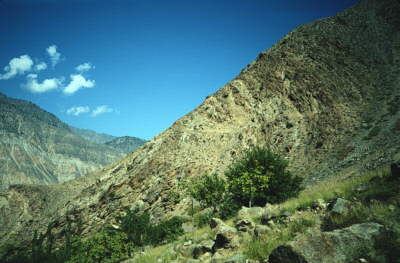
Discussion and Interpretation

The mapping of the Diamir-Airl Gah-Jalhari Shear Zone as the continuation along the western and southwestern margin of the NPHM of the Raikot Fault can be integrated with our previous results to show the overall structure of the Nanga Parbat part of the NPHM. This data, summarised on our map (Fig 2)and section (Fig 4) strengthens our previous conclusion that the large-scale structure is that of an antiformal "pop-up" related to displacement on the major discontinuity of the Raikot-Liachar Fault, with secondary but significant antithetic movement on the Rupal-Chichi Shear zone, perhaps generated by a large-scale ramp in the subsurface on the extension of the Raikot Fault. The thermal [cooling age], metamorphic, and plutonic anomalies of the Nanga Parbat part of the NPHM are all contained within the outer boundaries of these two shear zones.
The abrupt northward thinning of cover sequences in Southwest NPHM is substantially too large to be original depositional variation and there must be some type of tectonic excision. Large amounts of STDS-type normal motion have not been reported from the MMT - only collapse folding (Burg et al., 1996) or diffuse shear type deformation within the footwall (Vince & Treloar, 1996). Similarly, we have found no compelling evidence for MMT normal motion and, accordingly, we look elsewhere to explain the observed excision. One interpretation is that an east over west reverse fault, sub-parallel with the Jalhari granite-gneiss shear zone, cut out the missing section, but this does not explain the similar relationship on the southeastern side of the NP massif. Such a fault would have to post-date the overturning of the MMT footwall sequences in the Gashit fold. Additionally it would have to be obscured by early plutonism related to the Jalhari granite. Figure 5 shows our more favoured interpretation, as well as the less-plausible alternatives. A frontal ramp in the original MMT is suggested to have created a large-scale duplex structure with imbricated slices of cover (and locally basement). This is consistent with our mapping in Niat Gah, the next main N-S valley to the west, where map pattern basement / cover relationships suggest large-scale imbrication below the MMT.
Our interpretation of crystallisation of the Jalahari granite between 3 & 9 Ma in the Diamir Valley, and as old as 12 Ma at Phailobat indicates that there were pulses of plutonism throughout this late Miocene interval. We have reported elsewhere the younger plutonism in the heart of the massif; the Mazeno Pass Pluton is >15 km from Diamir and has a Th-Pb monazite age of 1.4 Ma (Schneider et al., 1997), the Tato Pluton is >20 km from Diamir and has a U-Pb zircon rim age of ~1.0 Ma (Zeitler et al., 1993). Viewed together these ages indicate that plutonism at NPHM has continued since 12 Ma. Other workers (e.g., Wheeler et al., 1995) have emphasised the importance of crustal “fertility” (crustal melt-production capability) with respect to plutonism at Nanga Parbat and have suggested that basement at NPHM may not have “melted twice”. Our results show that discrete pockets of melt can be generated at any time, and there is no evidence of a single, widespread melting event. Recognising the relationship between local plutonism and large shear zones (c.f. Mazeno Pass Pluton), we infer that melt can be locally generated when suitable conditions of pressure, temperature, strain localisation, and nature of protolith and/or presence of fluids are attained. We note that the amounts of melt are small when compared to the High Himalayan leucogranites where single widespread melting events are thought to have occurred (e.g. Harrison et al., 1997). Our results indicate that tectonic evolution of Nanga Parbat is a dynamic and ongoing process, of which we have a present-day “snapshot”.